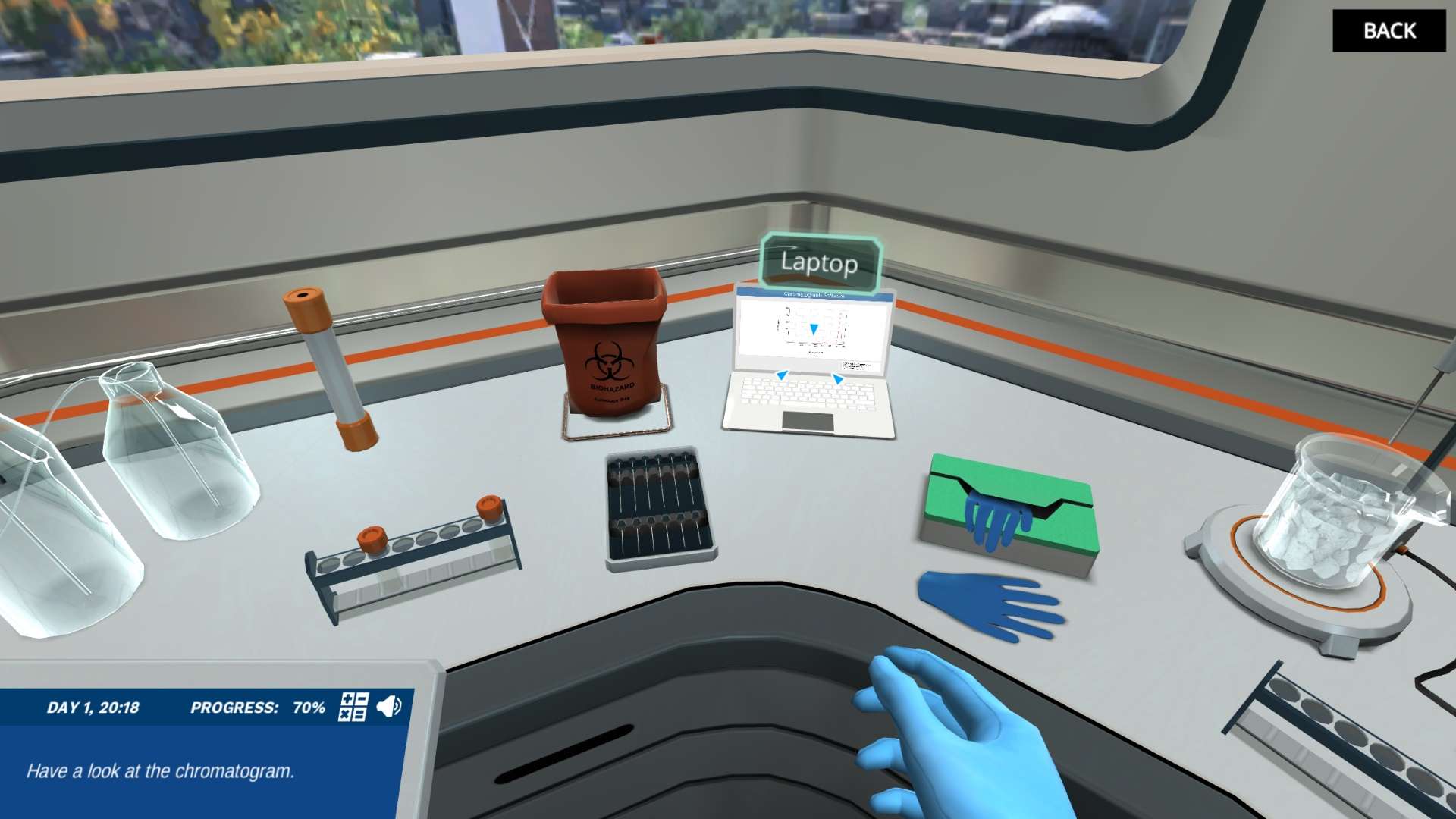Heading 1
Heading 2
Heading 3
Heading 4
Heading 5
Heading 6
Lorem ipsum dolor sit amet, consectetur adipiscing elit, sed do eiusmod tempor incididunt ut labore et dolore magna aliqua. Ut enim ad minim veniam, quis nostrud exercitation ullamco laboris nisi ut aliquip ex ea commodo consequat. Duis aute irure dolor in reprehenderit in voluptate velit esse cillum dolore eu fugiat nulla pariatur.
Block quote
Ordered list
- Item 1
- Item 2
- Item 3
Unordered list
- Item A
- Item B
- Item C
Bold text
Emphasis
Superscript
Subscript
About This Simulation
Use size exclusion chromatography (SEC) to prepare a sample of a protein involved in Parkinson’s disease! Discover how this technique can be beneficial in your lab experiments and create a hypothesis about the elution time of different-sized particles!
Learning Objectives
- Set up the apparatus required and follow the general workflow associated with liquid chromatography
- Detail the concept behind compound separation by size exclusion
About This Simulation
Lab Techniques
- Sonication
- Size exclusion chromatography
Related Standards
- EHEA First Cycle
- Early Stage Bachelors Level
- US College Year 1
- US College Year 2
- US College Year 3
- FHEQ 6
- SCQF 10
- SCQF 9
- Early Stage Bachelors Level
- Intermediate Stage Bachelors Level
- Late Stage Bachelors Level
- Early Stage Masters Level
- Intermediate Stage Masters Level
- Late Stage Masters Level
- FHEQ 7
- SCQF 11
- EHEA Second Cycle
- US College Year 5
- Chemistry Unit 3.9
- Chemistry B.2
Learn More About This Simulation
This short, targeted simulation is adapted from the full-length Parkinson’s Disease simulation.
Always wanted to know what a chromatograph is? In this simulation, you will learn about the exciting liquid chromatography equipment and discover how it’s used for preparing samples ahead of further experiments in the lab! Inject your sample into the SEC column and guess if the oligomer or a monomer of an interesting protein is eluted first!
Extract alpha-synuclein protein
You will learn about alpha-synuclein (aSN), a protein that is involved in the formation of Lewy bodies in the brain during the development of Parkinson’s disease. In order to start working with aSN, you will first use sonication to extract the protein, which is produced by an E. coli bacterial strain, and which was previously genetically modified by your lab assistant. Then, you will learn about the different parts of the liquid chromatography instrument, such as sample injector, fraction collector, and columns to get familiar with them before operating the equipment in the real lab.
Separate aSN monomers and oligomers
After the lab assistant has purified the aSN monomers and induced the formation of aSN oligomers, you will need to separate aSN monomers from oligomers using size exclusion chromatography.You need to make sure that you’re choosing the right mobile and stationary phase for your experiment, but you don’t need to worry about long time-consuming preparation steps, because time will be fast-forwarded so you can focus on evaluating the results!
Evaluate the chromatogram
In the end, you will get a chance to look at the chromatogram and analyze the elution volumes. Will you be able to use choose the right fraction that contains aSN oligomers?
For Science Programs Providing a Learning Advantage
Boost STEM Pass Rates
Boost Learning with Fun
75% of students show high engagement and improved grades with Labster
Discover Simulations That Match Your Syllabus
Easily bolster your learning objectives with relevant, interactive content
Place Students in the Shoes of Real Scientists
Practice a lab procedure or visualize theory through narrative-driven scenarios


FAQs
Find answers to frequently asked questions.
Heading 1
Heading 2
Heading 3
Heading 4
Heading 5
Heading 6
Lorem ipsum dolor sit amet, consectetur adipiscing elit, sed do eiusmod tempor incididunt ut labore et dolore magna aliqua. Ut enim ad minim veniam, quis nostrud exercitation ullamco laboris nisi ut aliquip ex ea commodo consequat. Duis aute irure dolor in reprehenderit in voluptate velit esse cillum dolore eu fugiat nulla pariatur.
Block quote
Ordered list
- Item 1
- Item 2
- Item 3
Unordered list
- Item A
- Item B
- Item C
Bold text
Emphasis
Superscript
Subscript
A Labster virtual lab is an interactive, multimedia assignment that students access right from their computers. Many Labster virtual labs prepare students for success in college by introducing foundational knowledge using multimedia visualizations that make it easier to understand complex concepts. Other Labster virtual labs prepare learners for careers in STEM labs by giving them realistic practice on lab techniques and procedures.
Labster’s virtual lab simulations are created by scientists and designed to maximize engagement and interactivity. Unlike watching a video or reading a textbook, Labster virtual labs are interactive. To make progress, students must think critically and solve a real-world problem. We believe that learning by doing makes STEM stick.
Yes, Labster is compatible with all major LMS (Learning Management Systems) including Blackboard, Canvas, D2L, Moodle, and many others. Students can access Labster like any other assignment. If your institution does not choose an LMS integration, students will log into Labster’s Course Manager once they have an account created. Your institution will decide which is the best access method.
Labster is available for purchase by instructors, faculty, and administrators at education institutions. Purchasing our starter package, Labster Explorer, can be done using a credit card if you are located in the USA, Canada, or Mexico. If you are outside of North America or are choosing a higher plan, please speak with a Labster sales representative. Compare plans.
Labster supports a wide range of STEM courses at the high school, college, and university level across fields in biology, chemistry, physics, and health sciences. You can identify topics for your courses by searching our Content Catalog.















